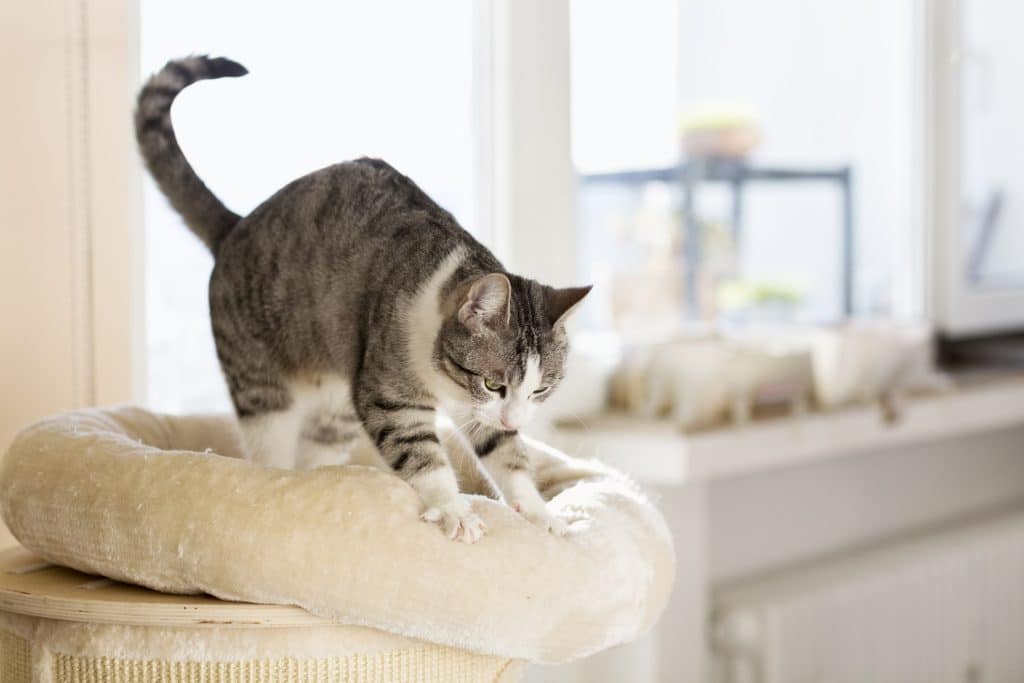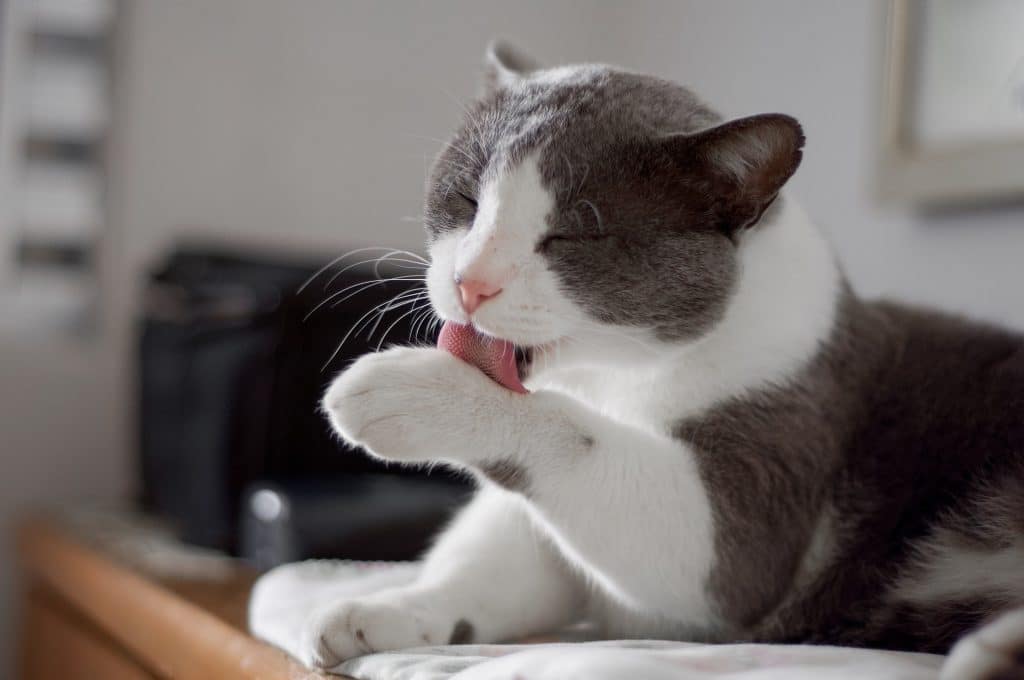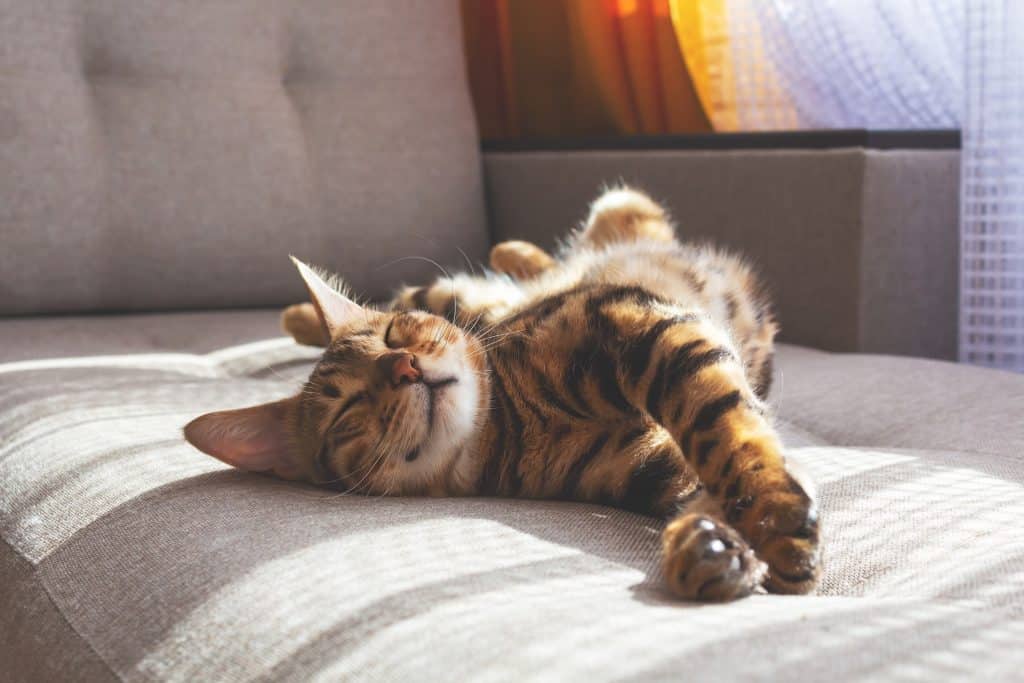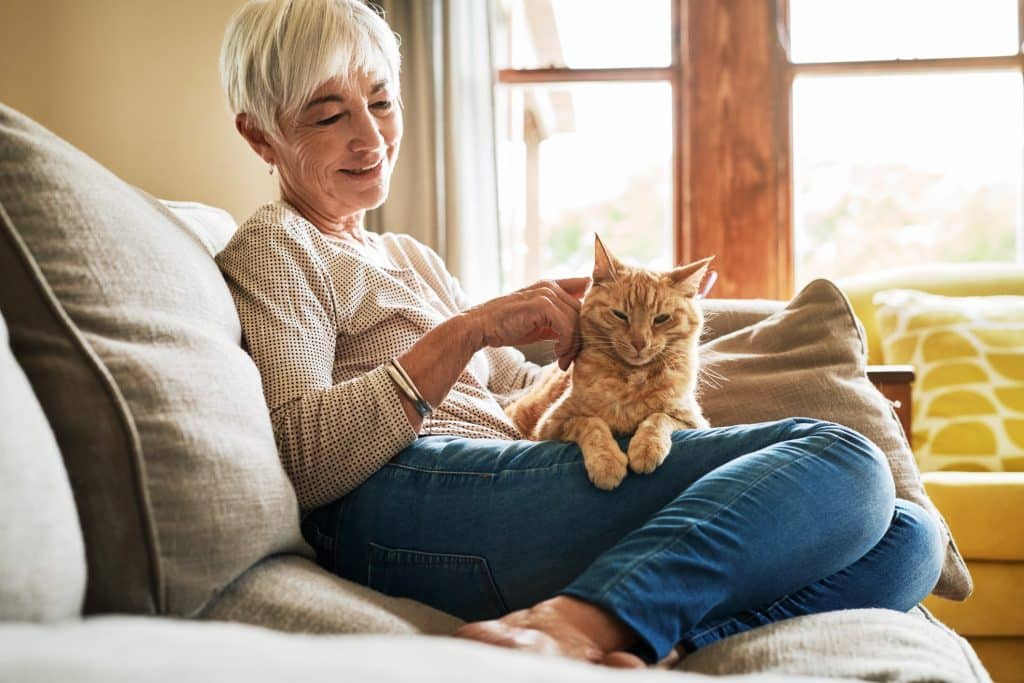As pet parents, we always want to ensure our cats are the happiest they can be. Cats don’t experience and express emotions in the same ways that we do—or even in the same ways that happy dogs express their feelings.
“Cats are never spiteful or purposefully mean, but they can feel happy, sad, or angry,” says Baltimore-based cat behavior expert Laura Cassiday, CCBC, ABCCT, FFCP. And no two cats are the same when it comes to feeling and expressing their emotions, either. But there are some universal signs we can look for that indicate our cats are happy and healthy.
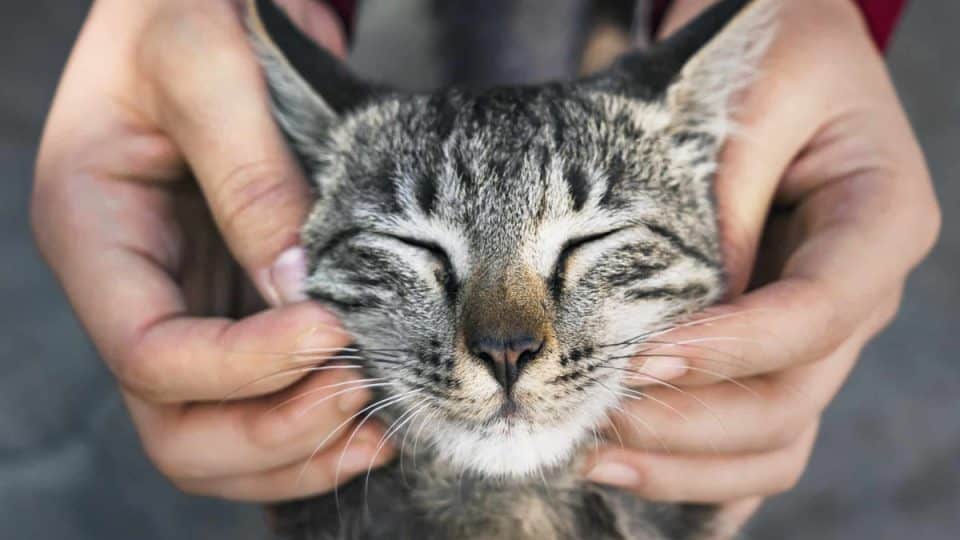
Signs of a happy cat include happy body language, increased vocalizations, an increased desire to cuddle or play, and normal grooming behaviors. Still not sure if you have a happy kitty at home or want to learn the ins and outs of happy cat behaviors? Experts say to look for these eight signs of a happy cat.
Your Cat Talks To You
Some cats like to hear themselves talk, Cassiday says. Other cats are quiet, even when they’re happy. And other cats want to tell everyone exactly how happy they are—it’s all about getting to know your cat’s unique personality. Happy cat vocalizations might include:
- Meowing. High-pitched meows and meows as greetings are especially happy. But if your cat is meowing more often than usual or if other changes in behavior accompany it, chat with your vet.
- Chattering or chirping. Usually reserved for good bird-watching sessions, cats chirp and chatter when they’re enjoying a visual stimulus.
- Trilling. This sound is a happy mix between a purr and a meow.
- Purring. A fluttering of the diaphragm and larynx, usually purring is a sign of happiness—but not always (more on that later).
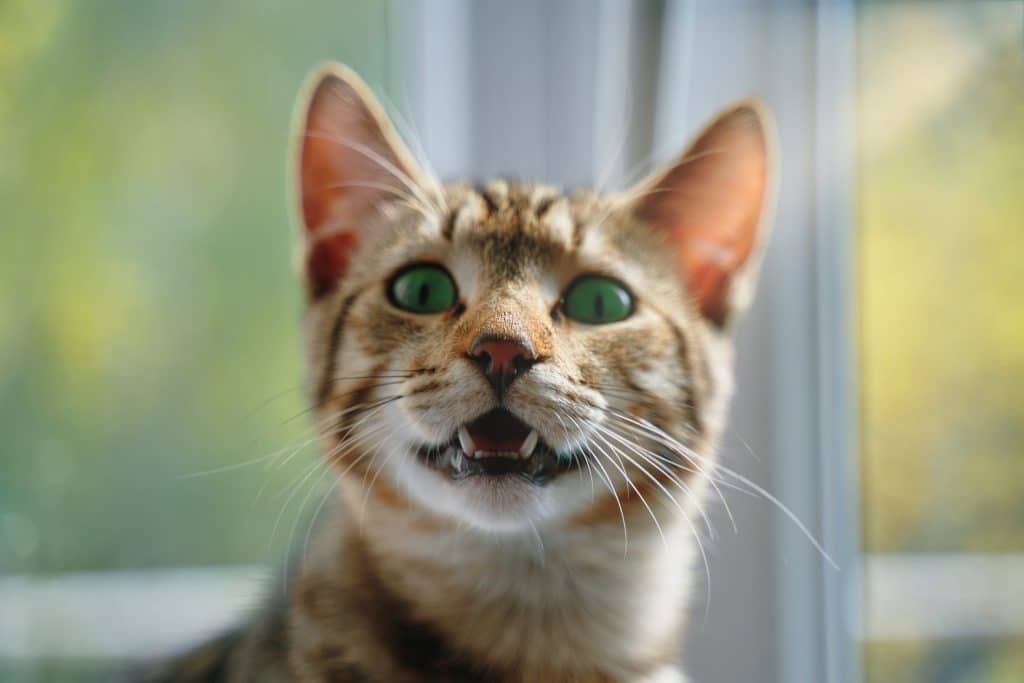
iStock/Savusia Konstantin
Cassiday notes that if a cat is sad or not feeling well, they’re more likely to be less vocal. “Stressed cats may yowl, growl, or hiss,” she says. You could think of these sounds as “distance-creating vocalizations” or warning someone or something to back off or stay away.
Does purring always mean a cat is happy?
Despite popular belief, purring isn’t always a sign of happiness. Instead, cats purr to self-soothe when stressed, hurt, or scared. It’s even thought that the vibration of the purr is just the right frequency to help heal bones, tendons, and wounds. “Use context clues to determine if purring is a sign of happiness,” Cassiday says.
The most obvious sign that a purr is happy is if a cat is purring while enjoying social interactions with humans or other animals. “If a cat is hiding in the back of a closet purring when no one is around, that’s a problem,” she says.
Your Cat Has Happy Body Language
Speaking of context clues, body language is a great way to know if your cat’s vocalizations and behaviors are happy ones. In fact, you can tell a lot about your cat’s mood by learning how to decipher a cat’s body language. Here are the most common happy and unhappy cat body language cues.
Happy cat body language
- A slow-moving, lightly-swishing tail or an upright tail
- Upright ears
- Slow blinks and winks
- Softly pawing for attention
- Pushing their head or face into your hand
- Rubbing against you
- Relaxed body posture, loafing, or kneading
Unhappy cat body language
- Tail lashing or thumping
- Pinned ears
- Wide eyes with dilated pupils
- Swatting you away
- Biting
- Walking away or hiding
- Puffed-up fur or twitching skin
Your Cat Kneads
Also called making biscuits, happy cats knead their paws on soft surfaces or their humans. You might notice that your cat is purring and happily drooling when kneading.
“When cats knead on you, they’re showing how happy and content they feel when they’re with you, just like they did when they were with their mama,” says Samantha Bell, a cat behavior expert at Best Friends Animal Society. It’s a natural, inherent behavior, and, chances are, most cats will be caught making biscuits at one time or another.
![A happy cat making biscuits]()
iStock/SilviaJansen
Your Cat Drools
Dribbling drool while making biscuits, relaxing, or being pet are all signs of a happy cat. Drooling isn’t just reserved for dogs! Not all cats drool when they’re happy, so it’s okay if your happy housecat doesn’t.
Drooling can also signify stress, fear, or illness, so pay close attention to context clues like body language and vocalizations.
Your Cat is Curious & Affectionate
Cats are more solitary animals than dogs are, but that doesn’t mean they aren’t social, says Dr. Lindsay Butzer, DVM, consulting veterinarian for PetMeds. “Cats enjoy more individual time and choose when they want to rub up against your leg to be petted,” she says. “And they are still very aware of how much love you give them.”
A cat’s range of social tendencies, curiosity, and affection toward other cats and humans varies, just like intra- and extroverted humans. But Dr. Butzer adds that a happy, well-socialized cat tends to be less timid or aggressive than cats experiencing stress.
In happy multi-cat households, “cats may play with each other, sleep next to or near each other, or engage in mutual grooming,” Cassiday adds. They may even engage in play fighting, which looks and sounds different than aggressive fighting.
Your Cat Wants To Play
Like their socially outgoing personalities, happy cats are more eager to play. But, of course, play can look different for every cat, especially as a kitten grows into adulthood and eventually settles into their senior years. So, try a variety of engaging toys that keep them on their toes!
“Playing with your cat regularly—twice daily in the morning and evening—is highly recommended and is the best way to reduce stress,” Cassiday says. When a cat doesn’t have the opportunity to exercise their mind and body, they might end up taking the frustration out on your couch, other pets, or your feet.
![A happy cat grooming themselves]()
iStock/Caíque de Abreu
Your Cat Eats, Sleeps & Grooms Normally
“The primary thing to look for in a happy cat is that they are comfortable performing their normal and natural behaviors,” Cassiday says. Sleeping, eating, and grooming habits vary, with some cats sleeping as many as 20 hours and others as little as 12. So, note what’s normal for your kitty and tell your vet if you spot any changes.
A healthy weight and coat are two of the best indicators that your cat is happy and healthy, adds Dr. Butzer. “An unkempt or greasy hair coat may mean your cat cannot groom themselves or isn’t grooming themselves, which can be a sign of weakness or being sick,” she says.
A change in eating and sleeping habits could indicate anything from feline cognitive disorder in senior cats to dental disease or being stressed out by a new family member.
Your Cat Uses The Litter Box Correctly
When your cat uses the litter box correctly, it means they’re happy and not experiencing medical conditions that might cause inappropriate urination or pooping outside the box. But if your cat does start eliminating outside the litter box, it’s not because they’re upset or getting back at you, although it can feel that way.
“Cats eliminate outside of the litter box because they are upset about something in their environment [or because they’re not feeling well], not because of you,” Bell explains. “Something in their environment is stressing them out, such as a new family member, a guardian who travels frequently, or any other major changes in the household.” But she adds before starting any cat behavior detective work, see your vet to rule out any medical conditions.
![A happy cat laying indoors]()
iStock/Anna Derzhina
Is My Cat Happy Indoors?
Some cats yearn for the outdoors, rushing to the door every time it opens and chattering at the birds from the windows. But do cats need to go outdoors to be happy? Nope, Cassiday says. Cats can live happy and fulfilling lives indoors with suitable physical and mental enrichment.
Outdoor cats have all the mental and physical stimulation they could want. But they’re also “exposed to a lot more things that can cause stress such as predators, traffic, illness and disease, and competition over food,” Cassiday says.
Even in small spaces, cats can get all the stimulation they need with vertical spaces, window perches, scratching posts, food puzzles, and interactive toys. Fighting boredom in cats doesn’t need to cost a lot, considering a cat’s love for boxes and paper bags. But if you want your cat to feel like they’re outside, Cassiday suggests building a catio or a safe, open-air enclosure for cats.
How Can I Make My Cat Happy?
A happy cat doesn’t just equal more cuddles and bonding time for you and your favorite feline. In addition, happy cats may have fewer stress-related health issues, such as fewer urinary tract infections (UTIs) or urinary blockages, and they may even have a lower risk of developing heart disease, says Dr. Butzer.
If you’re worried that your cat isn’t as happy as they could be, she adds that improving their happiness (and your cat-human bond) doesn’t need to be complicated, time-consuming, or expensive. Here are seven tips for making cats happy:
- Provide an enriching environment. “Enrichment is love,” Bell says. That means placing a few items in each room that your cat will enjoy interacting with. It could be as complex as a multi-tiered cat tree or as simple as a cardboard box sprinkled with tantalizing catnip.
- Talk to your cat. Dr. Butzer says that talking to a cat goes a long way in helping them feel loved. In addition, new research has shown that cats understand when we are speaking to and about them.
- Play with your cat daily. Cassiday shares that she has a set play schedule so her eight cats know exactly when to expect to play.
- Keep your cat clean and well-groomed. Brushing your cat replicates allogrooming, an essential tool for bonding.
- Keep your cat’s environment clean. “Scoop litter boxes twice a day and thoroughly clean them every 10 to 14 days,” Bell says.
- Make sure they have adequate food and water. Water fountains and automatic feeders make it easy never to miss a perfectly portioned, on-time meal when you’re on the go.
- Treat them with tasty treats. “Enrich their senses of smell and taste with a novel protein treat for them like freeze-dried turkey hearts,” Bell suggests. Treats shouldn’t make up more than ten percent of your cat’s daily calorie needs.
![A happy cat sitting on top of their pet parent]()
iStock/Dean Mitchell
Bell says that cats definitely have their own love language when it comes to expressing and feeling loved. So taking the time to learn your cat’s love language can make you and your cat happy.
